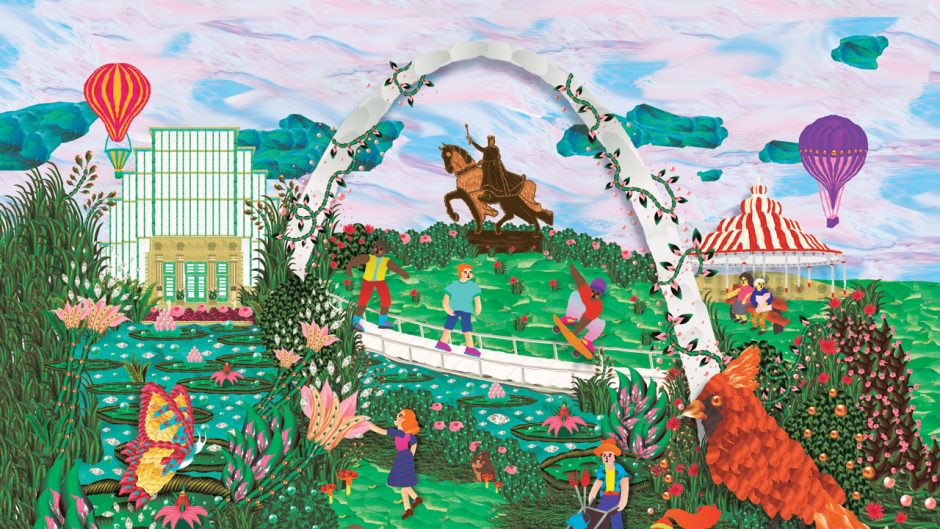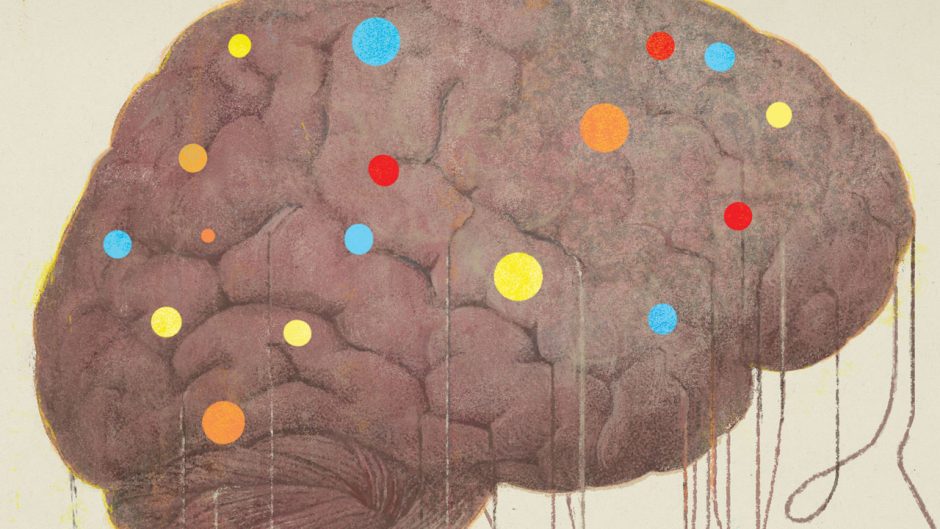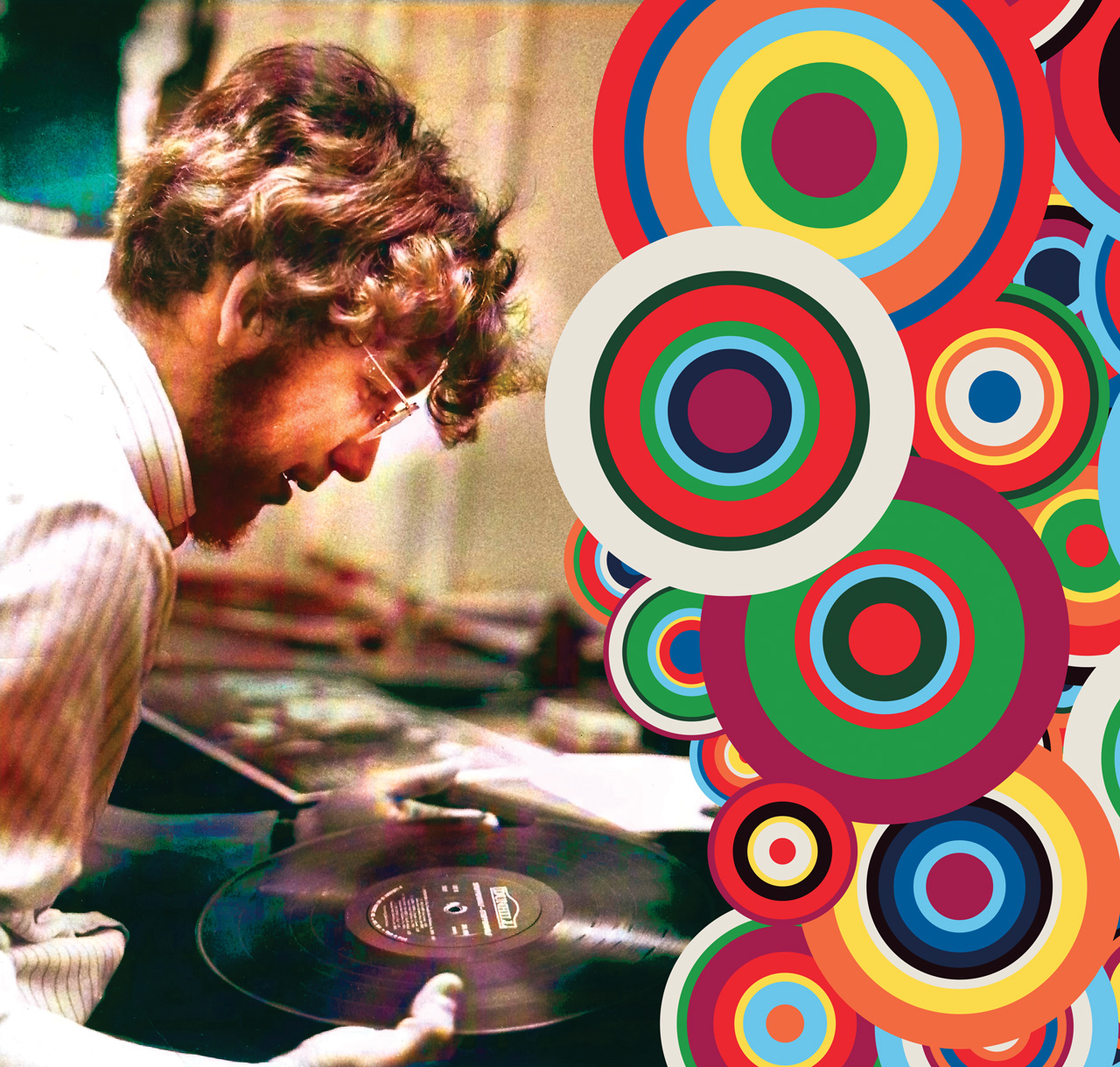
Aaron Mermelstein, BJ ’72 — once known as DJ Andy Moore — prepares to drop the needle on Steppenwolf’s greatest hits LP. Before KCCS hit the airwaves in 1964, dorm students had few choices — Hickman High School sports or a top 40 channel from Little Rock, Arkansas, which played what KCCS’ first station manager, Ed Wilsmann, called “high school country rock and roll.” Photo courtesy Aaron Mermelstein (colorized).
Published on Show Me Mizzou April 7, 2021
Story by Aaron Mermelstein, BJ ’72
Despite that “byline” thingy, the REAL person writing this twaddle is Andy Moore. Yes! Andy Moore!! And I — Andy Moore — am a rock and roll disc jockey on a red-hot playin’-the-hits and rockin’-the-oldies radio station at the University of Missouri! YES!!! YES!!!!! I’m a fast-talkin’, quick-witted, absolutely heeeeeeeeeee-LAR-ious wise-crackin’ hipster who knows what’s happening and is in on what’s gonna happen next, who knows what’s hot and knows who’s not! But stay with me now …… because in the light of the moon …… (audible sip of coffee) …… we’ll go …… UNNNNNNNNnnnnnnderground (echo fades: “UNNNNnnderground … UNNderground … underground”) … whole albums without interruption … (audible puff of cigarette) … maybe one artist for an hour … or some “experimental” or a little jazz … deep dive into the deep cuts you won’t hear anywhere else … ’cause it’s not about me, my friends, oh, no … (quietly) … oh, no … shhhhhhhhhh … on the Andy Moore show, it’s all about “The MEEEEEE-YOUUUUUUUU-sicccccccc” (echo fades: meee-youuuuu-siccccc … mee-youu-sicccc … me-you-sicc) ………
Just so you know, I said all of that out loud, all in one breath and in italics!
Oh, wait.
No, I didn’t.
I’m not a rock and roll disc jockey.
I’m not Andy Moore. I’m not any Moore.
I’m not any more.
But I was, by golly. I was.
Almost 50 years ago (I sigh), I was a disc jockey at KCCS. The Great 58. On-campus radio. Student radio. Owned by students. Run by students. With a students-only audience. And the DJ that I was once upon a time gave himself the radio name Andy Moore.
And even when I was Andy Moore, I knew in my brain and in my soul that I wasn’t by any means the italicized-idealized radio superstar described up there on top. Nope. Not even close. I was just a college kid more dedicated to campus radio than my GPA.
So when the editor-type person of this magazine foolishly assigned me to write “a personal memoir about KCCS, a wistful in-my-own-words essay overflowing with charming nostalgia, poignant reminiscences and sidesplittingly witty anecdotes” (though my memory is blurry about his exact words), my first reaction to the assignment was powerful. But at my age, acid reflux isn’t all that unusual. My second reaction was that long overwritten paragraph above, EXACTLY as you see it, in italics and with the effective and affective mood-setting ellipses included.
You see, despite the passage of nearly FIFTY YEARS (I sigh again), the instant Mister Editor-type person even mentioned KCCS, in my memory and in my spirit, I BECAME the rock and roll DJ described in the opening paragraphs all over again (even though I was never that guy in the first place)! I BECAME ANDY MOORE AGAIN!!! As I type this, I AM A.M.!!!! ANDY MOORE IS A ROCK AND ROLL DISC JOCKEY ON KCCS, THE GREAT 58!!!!!!
Even though I’m not.
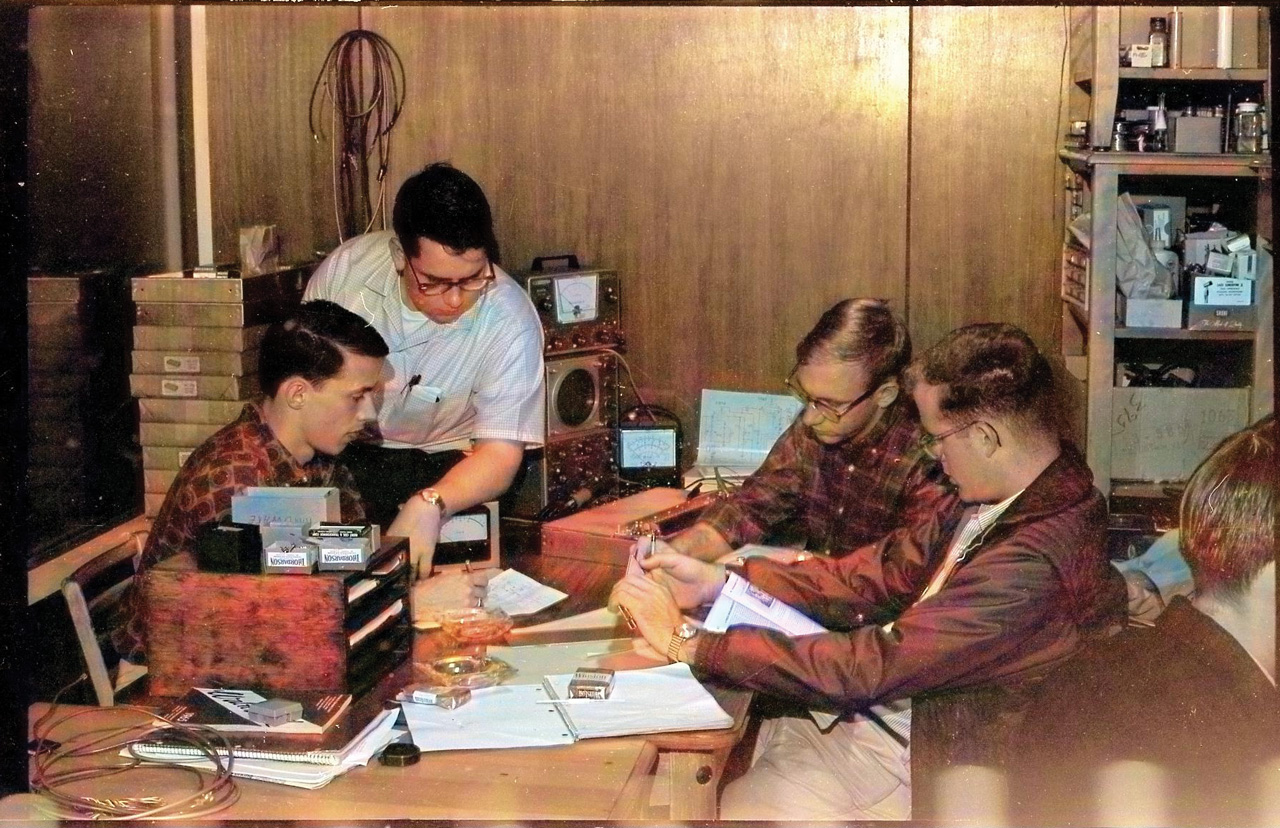
Over 50 student volunteers took part in KCCS operations. Jobs included program director, station manager, sports director, business manager, chief announcer, electrical engineers and disc jockeys. In the first full year of production, KCCS, found at 580 on the dial, was on air 18.5 hours a day and covered major campus events. MU Archives Collection C:22/8/72 (colorized)
Shoeboxes and Broom Closets
KCCS was “on-campus radio” at Mizzou. That is, parts of “on-campus” — university dormitories only. No other buildings, no Greeks, nowhere off campus. The station began in 1963 when enterprising students started broadcasting from the only space they could get, a broom closet. It died in 1973 in facilities larger than a broom closet but not much spiffier.
I was lucky enough to be at KCCS from my freshman year, 1968–69, until I graduated in 1972. I worked all four years as a disc jockey and also served as chief announcer, music director and station manager. Call me a rose-visioned romantic if you want, but I believe that by the time I arrived at KCCS the station had matured to the best, most creative, most significant time in its history. And although I personally hadn’t matured much whatsoever, I know for a rose-colored fact it was definitely my best time.
The station was owned by the Independent Residence Halls Association and located in the basement of Pershing Hall, the same level as the laundromat and snack bar, so there was always a slight “linty” scent in the air, mingling with the aroma of French fries.
The station’s AM radio signal went through telephone wires from the studios to a shoebox-sized transmitter in the basement of each dorm. Those magic shoeboxes shot a wimpy signal up into electrical wiring, metal piping and, presumably, orthodontia of the residents themselves so that the building itself became a gigundo transmitter broadcasting that just-barely-north-of-totally-powerless signal on the 580 frequency. Because of all that technological in-a-shoebox witchcraft, the station was called a “carrier current” station. The pioneering group that created the station named it KCCS as a bizarre abbreviation for the questionable “Kampus Carrier Current Station,” a decision I hope they deeply regret even to this day.
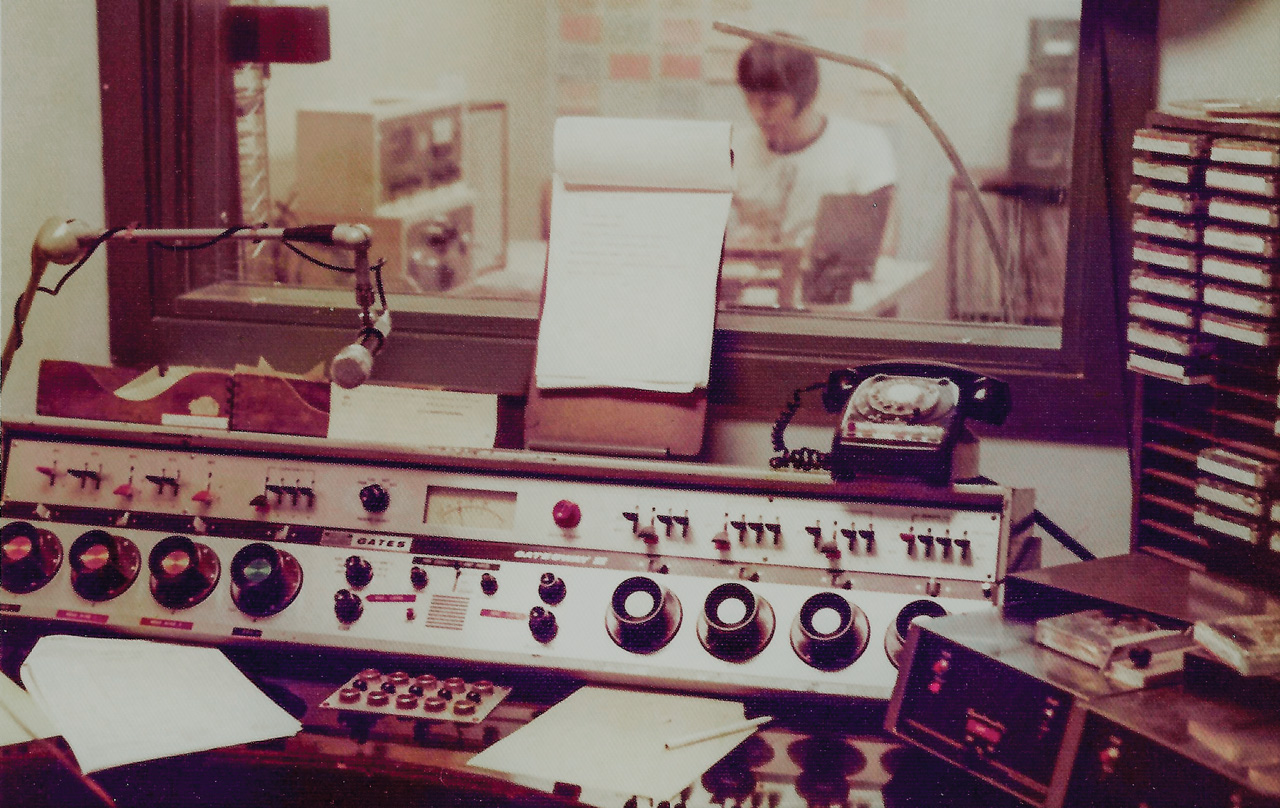
The Independent Residence Halls Association housed KCCS in two small offices in the basement of Pershing Hall, near a lounge and a laundromat, which staff remember as a constant source of noise. KCCS stood for Kampus Carrier Current Station. When it launched the No. 1 hit was “Can’t Buy Me Love” by the Beatles. Courtesy Aaron Mermelstein
Originally, the station broadcast from 3 p.m. to midnight, playing a variety of music including pop, folk and classical mixed with news and patter. Those early days featured quiet “study music” from 7 to 10 p.m., then show tunes and quiet “into the night” music until nighty-night-sleep-tight-don’t-let-the-bedbugs-bite signoff, though I am by no means implying that university dormitories were infested with bedbugs.
But by the late ’60s, the world and radio had both changed. The student audience the station played to wasn’t interested in show tunes or “study music” so, nighty-night be damned, KCCS evolved into a rocker that pumped out the hits from 6 a.m. to
1 a.m. seven days a week. It was a friendly-not-shouting, tight-format, no-dead-air, top-40-and-album-cuts (mostly) format in the image of the best stations in the country, theoretically.
Talent in all areas was exceptional and dedicated, from DJs to reporters and newscasters, sports people and record librarians. It even boasted a station meteorologist, a student majoring in climate science. The station did have some DJs as well as news and sports people who had trouble figuring out what all those buttons and the microphone did. Student radio.
As would be expected for Mizzou, the news department was huge, effective and efficient, with newscasts at :28 and :58 after the hour and 15-minute “monster newscasts” at 6 p.m. and 10 p.m., all filled with original reporting and tape actualities. The sports department broadcast play-by-play of Missouri baseball games.
Occasionally, KCCS broadcast old-timey radio serials because they were classics and also because they were cheap or free. Every Halloween we’d air Orson Welles’ 1938 War of the Worlds and inevitably get calls from students who were creeped out by the Martian invasion. Certainly, that broadcast is still magnificent, though the “we’re scared” calls always made us suspect some sort of liquid or herbal mood alteration may have been involved. But I ask you, just how likely would that have been for the late 1960s or early ’70s?
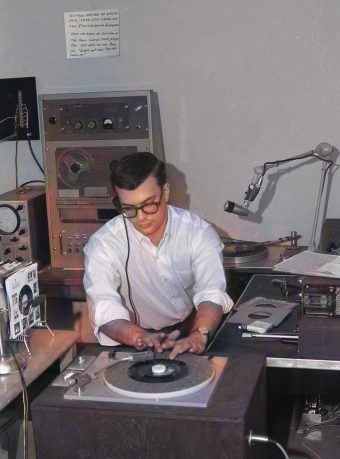
Milt Schwartz, BJ ’66, JD ’69, in the KCCS broadcast studio circa 1964. Schwartz launched MU’s first dorm radio station with his Baker-Park Hall roommate Ed Wilsmann, BS BA ’67, and was the station’s first general manager. Schwartz died in 1996. University Archives Collection C:22/8/72 (colorized)
Greasers, Daddy-Os and Cool Cats
So there we were, pumping it out 19/7. And people listened. Because radio was king. In those ancient days, dorm rooms didn’t have telephones, and almost nobody had a television. But everybody had a radio. Even students with stereos listened to radio to know which records to buy.
We didn’t have ratings or fancy-schmancy data collection, but we had the request/contest line, and it stayed busy. When DJs gave records to the eight-thousandth caller, they got eight-thousand calls (though my memory is blurry on the exact number of calls required to win).
One jock offered up some giveaway records to the first woman who showed up at the station wearing a swimsuit. In the dead of winter. More than a few showed up, all wearing winter coats over their bikinis. Admittedly, nobody approves of that kind of stunt in the 21st century, but in 1970 or thereabouts, it happened. More than once.
The station had listeners when it wasn’t even on the air.
One night, I was working/loitering/piddling around the station after the 1 a.m. signoff and after the power to the studios was turned off. But another guy needed to work in the production studio and turned the juice back on. For reasons still unknown, other than there was an electrified radio station in front of me, I put a record on the turntable, opened the microphone and intro’ed the song as if it were a normal part of any broadcast day. But because the station had signed off and no one was listening, I added “and this is the Great 58, on the air at a special time for all you damn dormies.” Whipsmart clever, right? And I made it up all by myself, right there on the spot!
The phone rang.
The caller said he kept his radio on overnight so the sign-on DJ would wake him at 6 a.m. He stressed his heavy displeasure with my description of him and his housemates, especially on the “damn dormie” radio station. When I told the morning DJ the story, he laughed and confessed he was terrified of that exact same guy and all the other keep-the-radio-on-all-night guys, fearing their fury if he was late for his shift and missed their wakeup. For readers who used KCCS as a literal clock radio, we were happy to serve. At least the morning guy was. No way I personally would have gotten up that early.
Extraordinary proof of listenership came in 1971 at the culmination of ’50s Week when the greatest hits of classic rock and roll were mixed into the playlist. To give ’50s Week a rockin’ finale, the station planned a sock hop in Pershing Lounge, just outside the station front door. We had no idea whether anyone would come.
Jaws dropped when greasers, chicks, daddy-os and miscellaneous cool cats packed Pershing Lounge, many dressed like the cast of West Side Story. Both gangs.
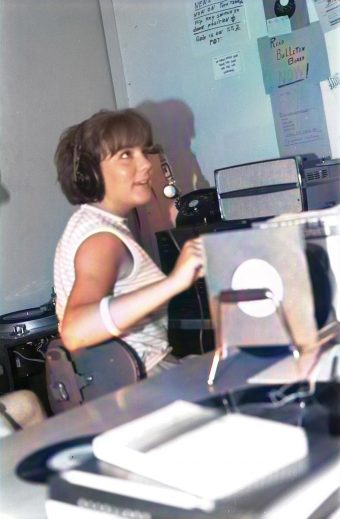
Pat Bridgman, BJ ’68, the station’s first news director, checks the clock during a newscast. Each afternoon, a newsroom volunteer was assigned to buy the first copy of the Columbia Missourian, which informed the 5 o’clock news. University Archives Collection C:22/8/72 (colorized)
Hundreds and hundreds packed the space, millions maybe (though my memory is blurry on the exact attendance), bopping and jiving with the kind of abandon and decadence predicted at the dawn of rocking around the clock. KCCS disc jockeys hosted, doing heeeeeeeeeeeee-LAR-ious patter for the crowd, running games and dance contests, giving away all the junker records we could find, and digging everywhere for more. Even the news and sports staff took the stage and finally got the recognition they deserved.
On that one night and in that one room, with a live, in-the-flesh audience dancing and having fun to our radio signal, the KCCS staff actually became celebrities. At least we felt like celebrities, even if we were just volunteer student DJs at the on-campus carrier current radio station. At colleges and universities everywhere, the athletes — the jocks — are always the biggest celebrities on campus. But that night, we were the biggest celebrities at Mizzou because we were jocks on KCCS radio.
Paul is Dead, Long Live Paul
I can’t write a “personal memoir/essay” about KCCS and omit the live broadcast of Paul McCartney’s death.
In the winter of 1970–71, decades before conspiracy theories became an industry, a story appeared in the newspaper reporting outrageous rumors circulating in Europe that mysterious “clues” in Beatles songs and on album covers hinted Beatle McCartney had died. Not only that — conspiracy of conspiracies — he’d been replaced by an EXACT lookalike, who sounded EXACTLY like him, moved, spoke, walked, breathed, went to dentist and cleaned the cat box EXACTLY like him, too. I tore the article from the paper so Andy Moore could discuss it on the air.
I was working the 9 to 11 p.m. shift, and the 11 p.m. to 1 a.m. jock came into the studio to say hello about a half-hour before his show. He said he’d also seen the article, and we joked about it on the air. Then curiosity took its natural hold. We started talking more seriously about the “rumors” and the alleged “clues:”
For example, play “Revolution 9” backward — yes, backward — and a strange voice says, “Turn me on, dead man.”
And at the end of “I Am the Walrus,” someone plainly says, “I buried Paul.”
Or that, on the Abbey Road cover, the Beatles walk across the street with each playing a character. John wears white, so he’s the minister. Ringo wears black like the undertaker. Then comes barefoot Paul, which obviously makes him the corpse — plus, the left-handed McCartney holds his cigarette in his right hand, an imposter!! And last comes George, dressed like a gravedigger, etc., etc., etc.
We played “clues” on the air and searched for more. Audience calls came quickly as listeners found clues we never would have discovered. We put all the callers on the air, some with findings incredibly far-fetched and some fabulously uncanny. There was enormous energy and a great sense of spookiness. Our one phone line was flooded. There were a gazillion credible clues (and my memory is not blurry on the exact number).
We discovered the station didn’t have the Magical Mystery Tour album, so one of the newsmen brought us his personal copy, breathlessly reporting that our show blasted throughout his dorm and that there were groups everywhere passing around albums and sharing “clues.” It seemed that almost everybody had turned on the live “turn me on, dead man” show. We noted the 1 a.m. signoff time but plowed ahead until 3 a.m. And the calls kept coming.
Nobody can say for sure, but we always felt that “Paul Is Dead” night was the most-listened-to night ever for KCCS. It demonstrated an incredible synergy between KCCS and our audience. We needed them, and, once and a while, we gave them what they wanted. Maybe even more than once and a while.
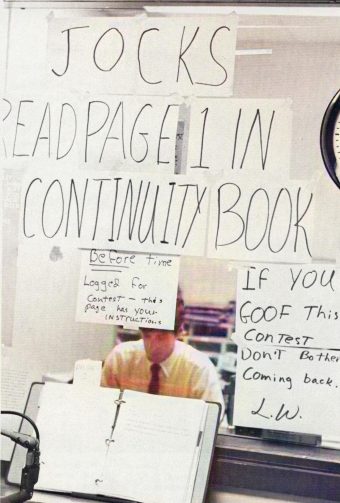
KCCS Studio A in the basement of Pershing Hall circa 1969. 1969 Savitar (colorized)
Of Pies and Plastic Bags
As you would expect from any endeavor filled with college students, KCCS was bursting with the unlimited creativity of tremendously talented smart-asses at the peak of their wiseacre postadolescent prime, cranking it out before the long, perilous descent into adulthood.
KCCS was a commercial radio station, and although ads were a source of income for the station, their creation was a creative opportunity far more important than money. I don’t remember the advertiser, but a crowd of us were struggling over the greatest technological challenge ever: creating the sound of someone being hit with a pie. It must’ve been a momentous selling point because we tried so many ways to solve the problem, including hitting someone in the face with a shaving cream pie, which actually wasn’t a remotely useable sound effect whatsoever. Ultimately, we discovered that water in a plastic bag — not too much, not too little — dropped to the countertop from exactly the right height — not too high, not too low — at precisely the correct distance from a microphone — not too … you get it — sounds plenty like pie striking face. So, the commercial could proceed. This pie-face discovery was the kind of groundbreaking innovation that made The Great 58 even greater and enhanced the station’s significant historic legacy to the world.
But creativity wasn’t just for hire; it came from everywhere and everyone and at every opportunity. When the Woodstock soundtrack came out, its un-airable cut was “The Fish Cheer,” in which Country Joe McDonald bellowed the strongest of all four-letter words, one letter at a time, each letter echoed back by hundreds of thousands of voices. With great craft, it was re-edited, repurposed and reordered to spell out K (“KAY!!!!”) C (“CEEE!!!”) C (“CEEE!!!”) F (“ESSSSSSSSSSS”) — because with a little reverb and the mystical power of suggestion, the letter F sounds unmistakably like an S on the radio. We had a perfect sounder of our call letters as cheered at the greatest music festival in history.
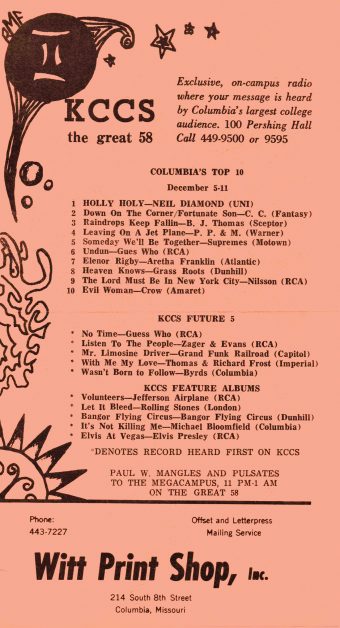
A KCCS music survey from the week of Dec. 5–11, 1969, created by then music director Aaron Mermelstein. The pink sheets were distributed free on campus and in the establishments of advertisers.
Salamis and Superheroes
But maybe the most successful single hunk of KCCS creativity was Schwadaman, a daily comedy superhero “radio serial.” The show carried that name because its superhero character was Schwadaman, who possessed no superpowers or powers of any sort. Or heroics. And relatively little character, for that matter. Schwadaman’s requisite sidekick was named Ho Chi Minh, a name that was, as they say, ripped from the headlines.
Meanwhile, as Schwadaman aired on KCCS, by totally and fantastically implausible coincidence, the chancellor of the Columbia campus was John Schwada. It was a tumultuous time at Mizzou, one of war and anti-war. Chancellor Schwada was at the figurative center when demonstrations erupted on campus in 1970 (all of which were covered more than admirably by the ever-professional KCCS news department, by the by).
But Schwadaman never ever brought up what was happening on campus, and Schwadaman never even mentioned Chancellor Schwada because Schwadaman didn’t reflect current events, wasn’t political, wasn’t social commentary and wasn’t biting satire. All Schwadaman and Schwadaman were was funny and silly and sophomoric. In the series finale, “Schwadaman and the Big Salami,” Schwadaman ends up aboard a NASA rocket (spoiler alert: The rocket was the “big salami”) to save the secret formula of the show’s sponsor Nerf, “Breakfast of Chimpanzees — also a mild detergent.” (Spoiler alert: Schwadaman and Ho Chi save it.)
And Schwadaman was immensely popular, largely popular at least. Pretty darn popular. We got constant phone calls asking when the next episode would air. Students (mostly boys, of course), quoted Schwadaman and especially Ho Chi Minh, for whom the eponymous Schwadaman was usually just the straight man. We considered selling T-shirts.
What Schwadaman was, most important of all, was naughty. It seemed dangerous for a character named Schwadaman to even exist at Mizzou at that time and on “campus radio.” We all felt it was something subversive that the station got away with, and although it seems silly to call it one now, back then it felt like a revolutionary act and that plotless, pointless, apolitical smart-assery was Schwadaman’s greatest attribute.
We never knew if Chancellor Schwada knew of the series, and we wondered whether he would have been angry or pleased if he did. Or wouldn’t have cared at all. We asked the same questions about Ho Chi Minh.
About this same time, there was talk of trying to establish an over-the-air FM station. As station manager, I opposed this because I worried the FCC-issued license would go to the University of Missouri board of curators instead of students. Frankly, I feared the adult supervision. I worried that, if the curators held the station license, nothing seditious like Schwadaman would ever be allowed again.
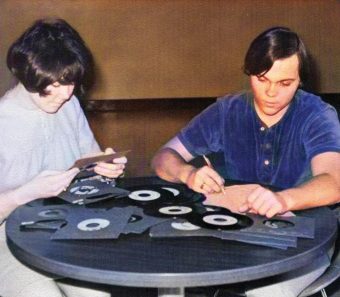
KCCS staffers catalog new records circa 1967. 1967 Savitar (colorized)
New Call Letters, New Generation
KCCS ended in 1973, when the 10-watt, over-the-air KCOU-FM (named after — sheesh — the Columbia airport designation), signed on and a whole new era of student radio began. Despite my fears of the FM license going to the board of curators, the group that put KCOU-FM on the air miraculously and laudably kept the license in the hands of students and the Independent Residence Halls Association.
KCCS stayed on the air for a time, but, because it was a carrier current station, it was never federally licensed. So, when a station in Oregon requested the call letters, the FCC granted the request. KCCS became KACK, which sounds more like a comic strip cat with a hairball than a radio station. But the magic shoeboxes ultimately went silent, and the old station finally faded into the wiring of the dormitories forever.
In the 1990s, “financial considerations” required that KCOU ownership transfer to the Missouri Students Association, and the license was reassigned to — TA-DA!!!! — the board of curators.
I think of carrier current KCCS often, whenever I hear music from that era via modern streaming or satellite technologies. I can still intro a record, though (I sigh), not as well as I did 50 years ago, as if I could do it well then. Nor can I do it with the same passion as then, no matter how hard I try (again I sigh — and it’s a big one this time).
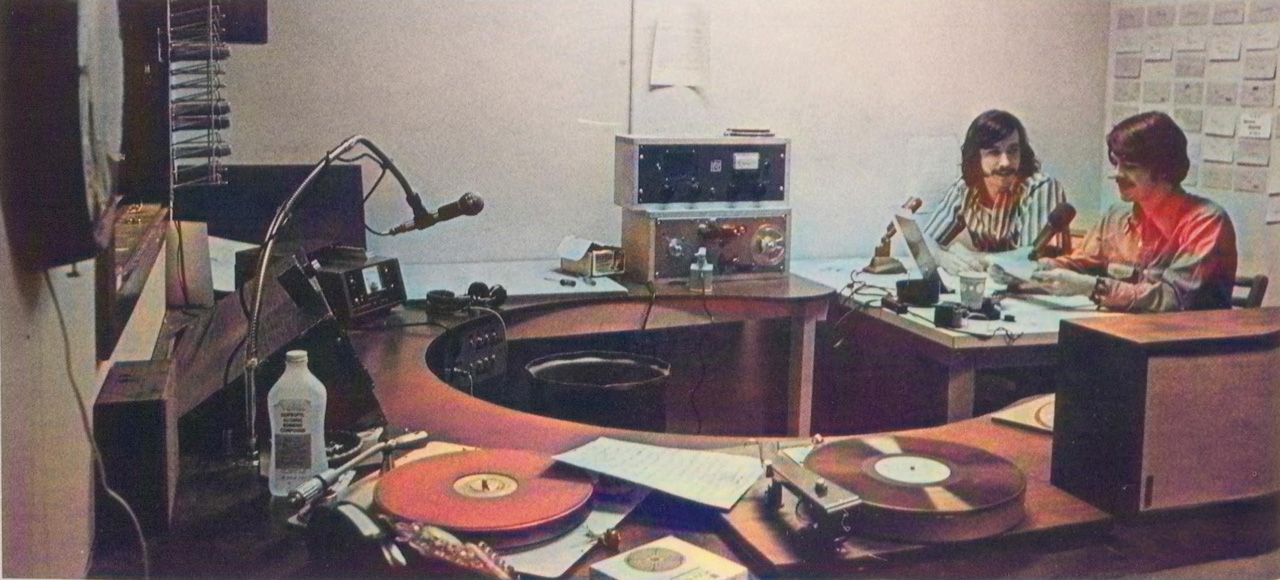
Two student volunteers conduct a newscast in KCCS Studio B, the production studio, circa 1972. At times, students could walk down the halls of every dorm and hear the KCCS signal. “On warm days, you could hear it through the open windows,” recalls station manager Ed Wilsmann. 1972 Savitar (colorized)
Many KCCS people stayed in radio, broadcast journalism or management. Some KCCS news people went to newspapers. Others went into PR or advertising, joined the family business, or did whatever it was they intended to do before they got involved in what was, for them, just a fun extracurricular.
With the exception of Schwadaman, I’ve left all the names out of this little essay extravaganza because, with the passage of time, my mind is blurry on just who did what. And I actually believe that, though there were definitely egos at KCCS (see: this piece that you’re reading in this magazine right now), I believe everybody did everything for the good of the station and not for ourselves as individuals. And besides, I probably made most of this up anyway.
I suspect I’ll hear about any mistakes or outright lies here via the official Facebook page for old KCCS people (not that there are any young KCCS people now), where we make fun of each other and reminisce about exactly the kind of campus radio baloney I’ve already over-reminisced about here. And inevitably — because it’s the only name they know me by — someone will call me Andy.
YES!! Andy Moore!! And I — Andy Moore — am a rock and roll disc jockey on a red-hot playin’-the-hits and rockin’-the-oldies radio station at the University of Missouri!
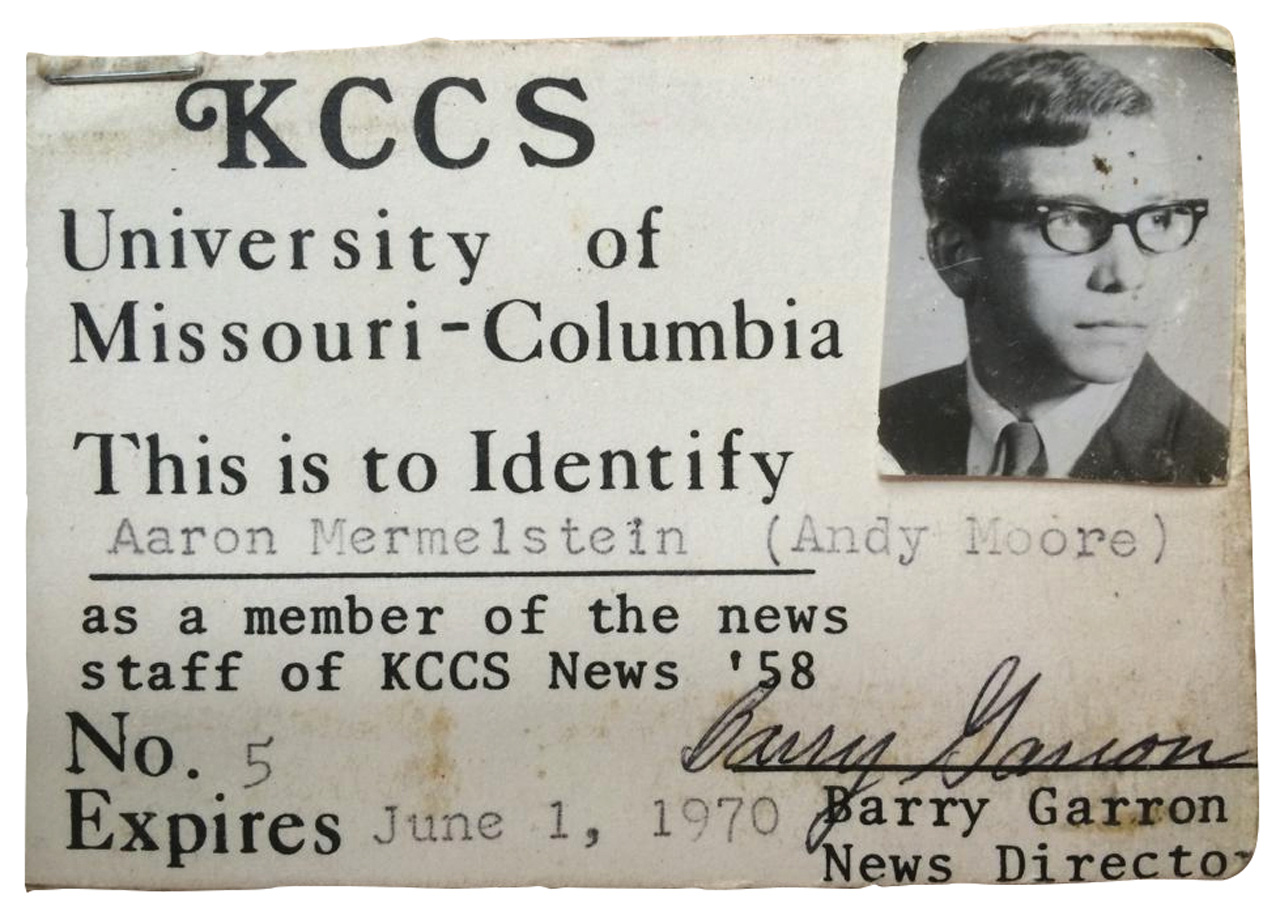
About the author: After KCCS, Aaron Mermelstein, BJ ’72, had a long career in local and network TV news, did a bit of newspapering, some syndicated radio and other media miscellanea. His 2013 novel, Octopus’ Garden, begins on the KCCS “Paul is dead” night and goes far beyond. He was never a disc jockey again.
Tell us about a favorite song, concert or KCCS memory from your college days. Email mizzou@missouri.edu.
To read more articles like this, become a Mizzou Alumni Association member and receive MIZZOU magazine in your mailbox. Click here to join.

